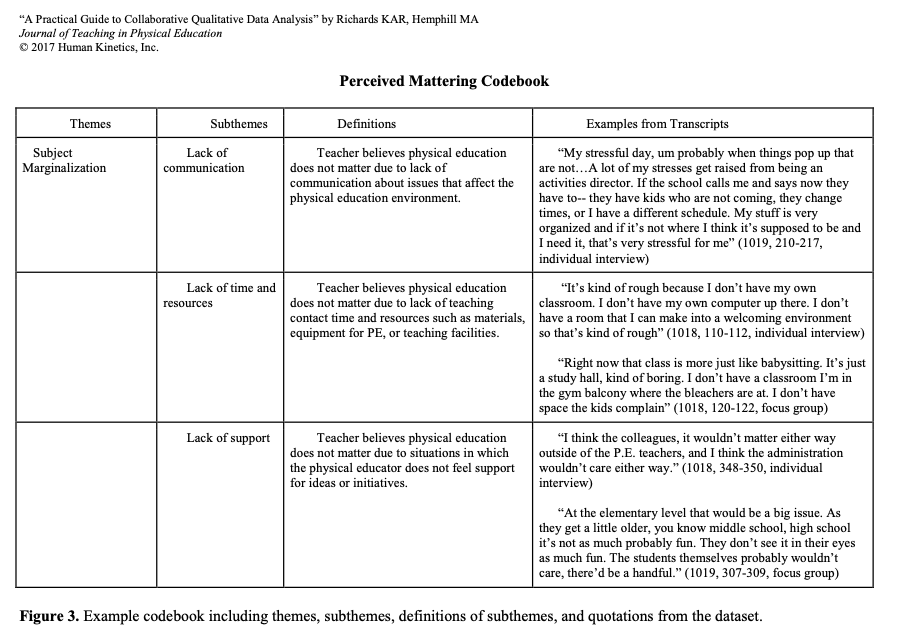How to Create a Qualitative Codebook
What is a Codebook in Qualitative Research?
A codebook in qualitative research is a document that lists all the codes used in your analysis, featuring clear definitions and illustrative examples of each. The codebook organizes the research process and helps tease out deeper insights from your data. It also helps research teams code more consistently as a group.
Qualitative Codebooks 101
Let’s quickly establish what a qualitative codebook looks like and what it usually includes. For each code in your qualitative research codebook, you want to convey contextual information such as:
A code definition
Practical examples of each code
Example of a qualitative codebook
Imagine you are analyzing how people use qualitative data analysis tools, like Delve. The codebook in the table below could categorize Behaviors such as re-reading transcripts or keeping track of quotes as observed behaviors, Collaboration as when researchers work together on the analysis, and Motivations as reasons like saving time or increasing transparency during analysis.
| Code | Description | Examples |
|---|---|---|
| Behaviors | Type of behaviors observed during research analysis | Re-reading transcript, keeping track of good quotes, looking for patterns |
| Collaborating | When groups of researchers collaborate on the same project | Working together as a team, co-analysis with clients |
| Motivations | Motivations behind why people decide to use an analysis tool | Saving time, staying organized, increasing transparency |
Why Create a Codebook for Qualitative Research?
By referring to the codebook regularly (and updating it when needed), you stay focused on your research questions and objectives. This helps avoid distractions from less relevant tangents and ideas. The document also helps groups code more consistently during collaborative qualitative analysis.
The codebook acts as a map that leads you to uncover patterns and themes in your data. It organizes your data to give you more time for actual data analysis, often leading to richer results. This is particularly important when using methods that rely on deep analysis or that work from large datasets, such as:
And because it’s worth repeating, a codebook can also help your readers understand your coding decisions and analysis. This document is a great way to help them see the data through your eyes and verify your results.
How to Determine What Qualitative Codes to Use?
To nail down the right codes to use for your research project, consider what you're aiming to discover and then determine whether you should take an inductive or deductive coding approach.
If you want to uncover new patterns in your data, inductive coding offers a “bottom-up” approach where you generate codes and themes alongside your data analysis. This approach is best for exploratory research where your codes and codebook are defined by new insights and theories as you research.
In deductive coding, you take a "top-down" approach to the data. You use a codebook or theory from existing research to prove or disprove your hypothesis. This approach focuses on confirming, refuting, or developing existing knowledge on a topic rather than discovering new patterns or theories.
Inductive and deductive coding are two different approaches to qualitative coding. You can choose one or the other to start figuring out your coding system or utilize a hybrid approach called abductive coding.
Choosing qualitative codes
After you pick your research approach, there are many ways to come up with your initial codes. Here are a few suggestions to get you started:
Choosing Inductive Codes
With an inductive coding approach, you can start with these steps:
Clearly define your research questions and objectives.
Review the data to develop a broad understanding of key concepts and themes.
Engage in iterative readings to identify recurring patterns or themes in the data.
Transform these insights into an initial list of codes relevant to your research topic.
Choosing Deductive Codes
For a deductive coding approach, start here:
Clearly define your research questions and objectives.
Choose a theory or framework as the basis for your study (e.g., Maslow's Hierarchy).
Identify and list codes derived from the selected theory or framework.
Most qualitative analysis is an iterative process. So whether using inductive or deductive coding, your codebook should evolve and adapt to new findings. Clear definitions help prevent overlapping ideas that need to be cleaned up later. Even in deductive coding, regular updates keep your work more relevant and insightful.
Qualitative analysis doesn't have to be overwhelming
Take Delve's free online course to learn how to find themes and patterns in your qualitative data. Get started here.

Sample Codebook for Qualitative Research [Template]
Now let’s take a look at a few more examples of how to create a codebook for qualitative data. You can use these hypothetical samples to get a better idea of where to get started.
Table 1: What you you’re looking for in your data: Participant reactions
Understanding how participants react is key to qualitative analysis. Using codes like ‘Apathy’, ‘Confusion’, and ‘Delight’ would help you decode nuanced responses, providing a valuable glimpse into how participants exhibited these concepts during interviews.
| Code | Definition | Examples |
|---|---|---|
| Apathy | Participant is apathetic to the concept shown | Lack of interest, no expression of concern, no discernable reaction |
| Confusion | Participant is confused and unclear about the concept shown | Asking many clarifying questions, unclear, misinterpretation |
| Delight | Participant is delighted with what is shown | Expressing enthusiasm, feeling joy, excitement |
Table 2: Theory or framework that’s the basis for your study: Maslow’s Hierarchy of Needs
This is a good example of how to apply an existing theory for deductive coding. Codes are ‘Physiological’, ‘Safety’, and ‘Belongingness’. The added ‘Theme’ column illustrates how you can connect, group, and organize your data during analysis for a more complete understanding of your research topic.
| Theme | Code | Definition | Examples |
|---|---|---|---|
| Human Needs | Physiological Needs | Basic needs for survival, such as stable housing, access to food security, healthcare system | Stable housing, access to food security, healthcare system |
| Human Needs | Safety Needs | Needs related to safety and security, including safety of the neighborhood, perception of crime, trust in community | Safety of the neighborhood, perception of crime, trust in community |
| Human Needs | Belongingness & Love Needs | Needs related to social connections and relationships, such as role in the family, stability of romantic relationships, feeling belonging in a peer group | Role in the family, stability of romantic relationships, feeling belonging in a peer group |
Codebook Examples From Published Research
Stepping away from hypotheticals, let's look at how codebooks are used in published research. These codebooks come from reputable/highly cited articles, showing how they are used in the field.
1. Richards and Hemphill (2017) present a detailed guide for how to improve trustworthiness in collaborative qualitative analysis (CQA). Using a project on physical education teachers navigating sociopolitical contexts, the authors introduce the "Perceived Mattering Codebook." This codebook addresses subject marginalization, featuring subthemes (communication, time/resources, and support), their definitions, and dataset quotes.
Image 1. Perceived Mattering Codebook with examples (Richards & Hemphill, 2017, pp. 225–231)
2. Tracy (2018) uses a phronetic iterative approach to data analysis in qualitative research, which is an iterative process of organizing, coding, and synthesizing qualitative data. She mentions key steps of the approach, including crafting a codebook, and provides an excerpt of the codebook used to analyze communicative behaviors in leadership scenarios.
Image 2. Excerpt of the codebook used to analyze communicative behaviors in leadership (Tracy, 2018, pp. 61-76)
3. In their study on social work research, Mackieson, Shlonsky, and Connolly (2019) discuss thematic analysis. Focusing on a document analysis of Canadian parliamentary debates, Table 1 provides a sample code definition for a high-level theme (FAMILY-FIRST). Table 2 provides a sample code definition for a sub-theme (FAM-NUCLEAR). The code definitions for the themes and sub-themes helped the authors categorize, analyze, and interpret the data in a systematic way.
Image 3. Sample codebook of a high-level theme from a document analysis (Mackieson et. al., 2019, pp. 965–980)
Image 4. Sample codebook of a sub-themes (codes) from a document analysis (Mackieson et. al., 2019, pp. 965–980)
Tools for Creating a Qualitative Research Codebook
You can use a variety of different tools for creating a qualitative codebook
Document editor like Word or Google Docs: This is a simple way to use a tool that you already have access to. Just make sure that as you’re changing your codes during analysis, you keep the qualitative codebook up to date!
Pen and paper: A physical codebook on paper can be particularly beneficial, especially if you manually analyze data with pen and paper. The tactile nature of paper provides a tangible advantage, although it can be laborious to recall information and risks losing data or insights.
Online CAQDAS software: Software like Delve streamlines the research process by letting you update your codebook in a web-based location. Delve also makes it easy to apply coding definitions, record memos in your codebook, and export it for peer debriefing or other purposes. When working with a team, online software for a codebook is especially helpful because it provides live updates for all team members.
Benefits of Using Delve Software
Add a code definition to your codebook
Manage a digital codebook with team members in real-time and easily export it to a word processor
Simple Sharing For Codebook Collaboration
Learn more about sharing and exporting your project on Delve.
Try Delve Software to Simplify Your Codebook
Qualitative data analysis software like Delve makes it easy to create, organize, and maintain your codebook. Get started with your free trial of Delve!
References:
Richards, K. A., & Hemphill, M. A. (2017). A practical guide to collaborative qualitative data analysis. Journal of Teaching in Physical Education, 37(2), 225–231.
Tracy, S. J. (2018). A phronetic iterative approach to data analysis in qualitative research. Journal of Qualitative Research, 19(2), 61-76.
Mackieson, P., Shlonsky, A., & Connolly, M. (2019). Increasing rigor and reducing bias in qualitative research: A document analysis of parliamentary debates using applied thematic analysis. Qualitative Social Work, 18(6), 965–980.
Cite this blog post:
Delve, Ho, L., & Limpaecher, A. (2023, Sept 21). How to Create a Qualitative Codebook https://delvetool.com/blog/codebook







